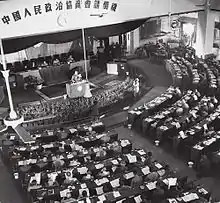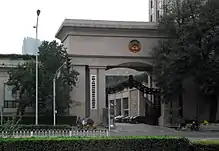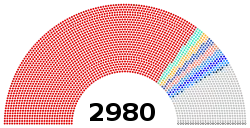Chinese People's Political Consultative Conference
The Chinese People's Political Consultative Conference (CPPCC, Chinese: 中国人民政治协商会议), also known as the People's PCC (Chinese: 人民政协, ![]() listen) or simply the PCC (政协), is a political advisory body in the People's Republic of China and a central part of the Chinese Communist Party's United Front system.[2] The body traditionally consists of delegates from the Chinese Communist Party (CCP) and its allied front organizations, eight legally-permitted political parties subservient to the CCP, as well as nominally independent members.[3][4][5] The CPPCC is chaired by a member of the Politburo Standing Committee of the Chinese Communist Party.[6]
listen) or simply the PCC (政协), is a political advisory body in the People's Republic of China and a central part of the Chinese Communist Party's United Front system.[2] The body traditionally consists of delegates from the Chinese Communist Party (CCP) and its allied front organizations, eight legally-permitted political parties subservient to the CCP, as well as nominally independent members.[3][4][5] The CPPCC is chaired by a member of the Politburo Standing Committee of the Chinese Communist Party.[6]
| Chinese People's Political Consultative Conference | |||||||
|---|---|---|---|---|---|---|---|
 | |||||||
| Simplified Chinese | 中国人民政治协商会议 | ||||||
| Traditional Chinese | 中國人民政治協商會議 | ||||||
| |||||||
| Short form | |||||||
| Simplified Chinese | 人民政协 | ||||||
| Traditional Chinese | 人民政協 | ||||||
| Literal meaning | People's Political Consultation | ||||||
| |||||||
| Shortest form | |||||||
| Simplified Chinese | 政协 | ||||||
| Traditional Chinese | 政協 | ||||||
| Literal meaning | Political Consultation | ||||||
| |||||||
| Third alternative Chinese name | |||||||
| Simplified Chinese | 新政协 | ||||||
| Traditional Chinese | 新政協 | ||||||
| Literal meaning | New Political Consultation | ||||||
| |||||||
.svg.png.webp) |
|---|
| This article is part of a series on the politics and government of China |
|
|
The National Committee of the Chinese People's Political Consultative Conference (Chinese: 中国人民政治协商会议全国委员会; pinyin: Zhōngguó Rénmín Zhèngzhì Xiéshāng Huìyì Quanguo Weiyuanhui, shortened Chinese: 全国政协; pinyin: Quánguó Zhèngxié; lit. 'National PCC') typically holds a yearly meeting at the same time as plenary sessions of the National People's Congress (NPC). The CPPCC National Committee and NPC plenary sessions are collectively called the Quanguo Lianghui ("National Two Sessions").
The organisational hierarchy of the CPPCC consists of a National Committee and regional committees. Regional committees extend to the provincial, prefecture, and county level. According to Article 19, Section 2 of the constitution of the CPPCC, the relationship between the National Committee and the regional committees is one of guidance and not direct leadership. However, an indirect leadership exists via the United Front Work Department at each level.[2][7]
The CPPCC is intended to be more representative of a broader range of people than is typical of government office in the People's Republic of China. According to Sinologist Peter Mattis, the CPPCC is "the one place where all the relevant actors inside and outside the party come together: party elders, intelligence officers, diplomats, propagandists, soldiers and political commissars, united front workers, academics, and businesspeople."[8] In practice, the CPPCC serves "the place where messages are developed and distributed among party members and the non-party faithful who shape perceptions of the CCP and China."[8] The composition of the members of the CPPCC changes over time according to national strategic priorities.[9] Previously dominated by senior figures in real-estate, state-owned enterprises, and "princelings", the CPPCC in 2018 was primarily composed of individuals from China's technology sector.[10]
History

The Conference dated prior to the existence of the People's Republic of China. During negotiations between the Chinese Communist Party and the Kuomintang in 1945, the two parties agreed to open multiparty talks on post-World War II political reforms via a Political Consultative Conference. This was included in the Double Tenth Agreement. This agreement was implemented by the National Government of the Republic of China, who organised the first Political Consultative Assembly from January 10–31, 1946. Representatives of the Kuomintang, Chinese Communist Party, Chinese Youth Party, and China Democratic League, as well as independent delegates, attended the conference in Chongqing.
In 1949, with the Communist Party having gained control of most of mainland China, they organised a "new" Political Consultative Conference in September, inviting delegates from various friendly parties to attend and discuss the establishment of a new state. This conference was then renamed the People's Political Consultative Conference. The first conference approved the Common Program, which served as the de facto constitution for the next five years. The conference approved the new national anthem, flag, capital city, and state name, and elected the first government of the People's Republic of China. In effect, the first People's Political Consultative Conference served as a constitutional convention.
From 1949 to 1954, the conference became the de facto legislature of the PRC. In 1954, the Constitution transferred this function to the National People's Congress.
Present role
The role that CPPCC plays in the Chinese government is stated in the preamble of the PRC Constitution. In practice, its role and powers are somewhat analogous to an advisory legislative upper house and there have been proposals to formalise this role in the PRC Constitution, making its National Committee a de facto national senate and its committees in all of the administrative divisions the upper chambers of their respective legislative branches.
—Preamble of the Constitution of the People's Republic of China[11]
But according to China's official Xinhua News Agency, it is neither a body of state power nor a policymaking organ, but an important platform for democratically participating in state affairs. In practice, CPPCC members serve as advisors for the government and legislative and judicial organs.[12]
The Chinese Communist Party and the aligned "democratic parties" participate in the CPPCC. Besides political parties, CPPCC has also representatives from various sectors of society in its ranks.[13] The parties and groups with representatives to the CPPCC are as follows:
- Chinese Communist Party
- Revolutionary Committee of the Chinese Kuomintang
- China Democratic League
- China Democratic National Construction Association
- China Association for Promoting Democracy
- Chinese Peasants' and Workers' Democratic Party
- China Party for Public Interest
- September 3 Society
- Taiwan Democratic Self-Government League
- Communist Youth League of China
- All-China Federation of Trade Unions
- All-China Women's Federation
- All-China Youth Federation
- All-China Federation of Industry and Commerce
- China Association for Science and Technology
- All-China Federation of Taiwan Compatriots
- All-China Federation of Returned Overseas Chinese
- Democratic Alliance for the Betterment and Progress of Hong Kong
- Business and Professionals Alliance for Hong Kong
- Hong Kong Federation of Trade Unions
- Liberal Party (Hong Kong)
- New Century Forum
- New Territories Association of Societies
- Macau United Citizens Association
- Macau Business Interest Union
- Macau Union of Professional Interests
- Progress Promotion Union/General Union of the Macao Residents' Associations
- Union for Development/The Women's General Association of Macau
National Committee

Standing Committee
- Chairmen
Past Chairmen of the committee and the current Chairman:
- Mao Zedong
- Zhou Enlai
- Deng Xiaoping
- Deng Yingchao
- Li Xiannian
- Li Ruihuan
- Jia Qinglin
- Yu Zhengsheng
- Wang Yang (since March 2018)
- Current Vice Chairpersons
- Current Secretary-General
- Xia Baolong (2018–incumbent)
Special Committees
The CPPCC National Committee has 10 Special Committees:
- Committee for Handling Proposals (提案委员会)
- Committee for Economic Affairs (经济委员会)
- Committee for Agriculture and Rural Affairs (农业和农村委员会)
- Committee of Population, Resources and Environment (人口资源环境委员会)
- Committee of Education, Science, Health and Sports (教科卫体委员会)
- Committee for Social and Legal Affairs (社会和法制委员会)
- Committee for Ethnic and Religious Affairs (民族和宗教委员会)
- Committee of Culture, History and Study (文化文史和学习委员会)
- Committee for Liaison with Hong Kong, Macao, Taiwan and Overseas Chinese (港澳台侨委员会)
- Committee of Foreign Affairs (外事委员会)
Annual sessions
- 2006 CPPCC Plenary Session
Composition of members
There have been 2200 members in the 12th National Committee of CPPCC since June 2017:[14]
- Seats for Political Parties (536 in all)
- Chinese Communist Party (97)
- Revolutionary Committee of the Kuomintang (65)
- China Democratic League (65)
- China National Democratic Construction Association (64)
- China Association for Promoting Democracy (45)
- Chinese Peasants' and Workers' Democratic Party (45)
- China Zhi Gong Party (29)
- Jiusan Society (44)
- Taiwan Democratic Self-Government League (20)
- Independents (62)
- Seats for People's organizations (307 in all)
- Communist Youth League of China (9)
- All-China Federation of Trade Unions (60)
- All-China Women's Federation (64)
- All-China Youth Federation (28)
- All-China Federation of Industry and Commerce (61)
- China Association for Science and Technology (43)
- All-China Federation of Taiwan Compatriots (15)
- All-China Federation of Returned Overseas (27)
- Seats for Sectoral representatives (1357 in all)
- Sector of Literature and Arts (142)
- Sector of Science and Technology (110)
- Sector of Social Science (71)
- Sector of Economics (149)
- Sector of Agriculture (67)
- Sector of Education (113)
- Sector of Sports (21)
- Sector of Press and Publication (44)
- Sector of Medicine and Health (88)
- Sector of International Friendship Activists (42)
- Sector of Social Welfare and Social Security (37)
- Sector of the Ethnic Minorities (101)
- Sector of Religions (65)
- Specially Invited Hong Kong Representatives (124)
- Specially Invited Macao Representatives (29)
- Macau United Citizens Association (1)
- Macau Business Interest Union (1)
- Macau Union of Professional Interests (2)
- Progress Promotion Union/General Union of the Macao Residents' Associations (1)
- Union for Development/The Women's General Association of Macau (1)
- Other Specially Invited Dignitaries to the Conference (including service personnel of the People's Liberation Army and the People's Armed Police) (154)
The People’s Political Consultative Daily
The People’s Political Consultative Daily (《人民政协报》) is the press window of information on direct policies and viewpoints of the CPPCC. Like most of the Chinese political organs, the newspaper serves as the mouthpiece and press for the conference. Compared with other governmental newspapers, such as The People's Daily or The PLA Daily, The People’s Political Consultative Daily is not as hardline, but rather smooth in terms of wording. This is geared towards the nature of the organisation, in which also many non-CCP members participate.
Regional committees
- CPPCC province-level committees
- CPPCC prefecture-level committees
- CPPCC county-level committees
See also
- Chinese Literature and History Press, the CPPCC's publishing house
- People's organization
- United Front (China)
- List of current members of CPPCC by sector
References
- "测试页面". Archived from the original on 2018-01-13. Retrieved 2018-01-13.
- Bowe, Alexander (August 24, 2018). "China's Overseas United Front Work: Background and Implications for the United States" (PDF). United States-China Economic and Security Review Commission. Archived (PDF) from the original on September 9, 2018. Retrieved May 12, 2019.
- Pauw, Alan Donald (1981). "Chinese Democratic Parties as a Mass Organization". Asian Affairs. 8 (6): 372–390. ISSN 0092-7678. JSTOR 30171852.
- Rees-Bloor, Natasha (2016-03-15). "China's largest political conference – in pictures". The Guardian. ISSN 0261-3077. Retrieved 2020-09-13.
- "The United Front in Communist China" (PDF). Central Intelligence Agency. May 1957. Archived (PDF) from the original on January 23, 2017. Retrieved June 10, 2020.
- Joske, Alex (June 9, 2020). "The party speaks for you: Foreign interference and the Chinese Communist Party's united front system". Australian Strategic Policy Institute. Archived from the original on June 9, 2020. Retrieved 2020-06-10.
- Dotson, John (May 29, 2020). "Themes from the CPPCC Signal the End of Hong Kong Autonomy—and the Effective End of the "One Country, Two Systems" Framework". Jamestown Foundation. Archived from the original on 2020-06-07. Retrieved 2020-06-03.
- Cole, J. Michael; Hsu, Szu-chien (2020-07-30). Insidious Power: How China Undermines Global Democracy. Eastbridge Books. pp. 3–39. ISBN 978-1-78869-213-7.
- Tatlow, Didi Kirsten (2016-03-03). "Advisory Body's Delegates Offer Glimpse Into China's Worries". The New York Times. ISSN 0362-4331. Retrieved 2020-09-13.
- Yu, Xie; Leng, Sidney (2018-03-04). "Tech entrepreneurs dominate as China's political advisers in IT push". South China Morning Post. Archived from the original on 2018-03-05. Retrieved 2018-03-06.
- "The National People's Congress of the People's Republic of China". www.npc.gov.cn. Archived from the original on 2016-02-06. Retrieved 2018-01-05.
- Q&A: Roles and functions of Chinese People's Political Consultative Conference Archived 2018-09-21 at the Wayback Machine Archived 2018-09-21 at the Wayback Machine www.xinhuanet.com
- "Charter of the Chinese People's Political Consultative Conference". www.cppcc.gov.cn. Archived from the original on 2018-01-02. Retrieved 2018-01-01.
- "Archived copy" 中国人民政治协商会议第十二届全国委员会委员名单. www.cppcc.gov.cn (in Chinese). Archived from the original on 2018-01-06. Retrieved 2018-01-01.CS1 maint: archived copy as title (link)
External links
| Library resources about Chinese People's Political Consultative Conference |
_logo.svg.png.webp)

